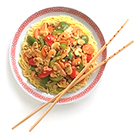 |
Chinese cuisine is a fascinating mix of diversity and simplicity, combining a few basic cooking styles with a willingness to experiment with whatever ingredients are available, whether these are native to the area or introduced by a foreign culture. Westerners have long appreciated Cantonese cuisine, with its subtle seasonings, abundance of seafood, vegetable, and rice dishes, and use of exotic ingredients such as shark's fin. However, China has at least four distinct regional cuisines, each one reflecting differences in geography, climate, and historical influences. Szechwan cooks got their first taste of spicy foods from Buddhist missionaries traveling along the Silk Route. Isolated from the rest of China by mountain ranges, they proceeded to independently develop the incendiary cuisine for which Szechwan is now famous. Commonly used ingredients such as Szechwan peppercorns and chilies add spicy heat to dishes. Garlic and scallions (green onions) are frequently used in northern dishes. Instead of rice, northerners favor wheat-based foods such as noodles and dumplings, since wheat is easier to grow in the colder northern climate. In eastern China, Shanghai residents have perfected the art of red cooking, where meat is cooked in dark soy sauce until the meat absorbs all the liquid and takes on a reddish color. Source: HungryMonster Writers |





